The Social and Behavioural Aspects of Climate Change
Linking Vulnerability, Adaptation and Mitigation
Pim Martens editor Chiung Ting Chang editor
Format:Hardback
Publisher:Taylor & Francis Ltd
Published:1st Sep '10
Currently unavailable, and unfortunately no date known when it will be back

This book argues that the inherent complexity of climate change will ultimately require a more integrated response both scientifically as well as at the scientific/policy interface, where new forms of engagement between scientists, policy-makers and wider stakeholder groups can make a valuable contribution to informed climate policy and practice.
Over the past few years, and certainly since the publication of the "Stern Report", there has been increasing recognition that climate change is not only an environmental crisis, but one with important social and economic dimensions. There is now a growing need for multi-disciplinary research and for the science of climate change to be usefully translated for policy-makers.Until very recently, scientific and policy emphasis on climate change has focused almost exclusively on mitigation efforts: mechanisms and regulations to reduce greenhouse gas emissions. The success of such efforts to date is debatable. In fact, the impact of ever more stringent emission control programmes could potentially have enormous social consequences. Little effort has been expended on the exploration of a systematic evaluation of climate stabilization benefits or the costs of adapting to a changed climate, let alone attempting to integrate different approaches. There is an increasing recognition that the key actors in the climate crisis also need to be preparing for change that is unavoidable. This has resulted in a greater consideration of vulnerability and adaptation.The book, based on the research programme "Vulnerability, Adaptation and Mitigation" (VAM) which ran from 2004 to 2010, funded by the Netherlands Organisation for Scientific Research (NWO), presents a cluster of case studies of industries, communities and institutions which each show how vulnerability, adaptation and mitigation analyses can be integrated using social behavioural sciences. Each chapter makes specific recommendations for the studied industry sector, community or institution, analyses the latest research developments of the field and identifies priorities for future research.
The book argues that the inherent complexity of climate change will ultimately require a much more integrated response both scientifically – to better understand multiple causes and impacts – as well as at the scientific/policy interface, where new forms of engagement between scientists, policy-makers and wider stakeholder groups can make a valuable contribution to more informed climate policy and practice.The book is particularly timely as the scientific research and policy debate is shifting from...
Climate Change is a topic that affects everyone in some way. Those not yet convinced of this statement are well advised to read The Social and Behavioural Aspects of Climate Change. In 12 case studies and five essays, mostly written by Dutch academics, the book successfully presents the variety of ways in which Climate Change influences businesses, science, policies and individuals. The Social and Behavioural Aspects of Climate Change is a product of the research programme VAM (Vulnerability, Adaptation and Mitigation) which was conducted by the NWO (Netherlands Organisation for Scientific Research) since 2004. The main objective of the efforts is to underline the need for input of the social sciences in the battle against Climate Change. The programme ran until 2010 and has its key results summarised in the book. The editors and authors of the individual chapters put great effort to taking the reader with them at every step. This is to meet the challenge that naturally comes from writing a book about a rather new topic that is being discussed from many different perspectives. The reader gains insights into complex topics without getting frustrated about lacking background knowledge in these specialised fields. As a result, every reader can benefit from the thought-provoking text, regardless of whether they are an old hand at Climate Change matters or comparatively new to the topics. The case studies are categorised in three clusters – "Industry", "Local Communities" and "Institutions". To pick out an example, the opening case study deals with the consequences climate change has for the inland navigation between the Netherlands and Germany. As the water level rises and drops more dramatically and more unpredictably due to Climate Change, the economic impact on welfare has to be taken seriously. Unresolved questions of how to distribute the costs of infrastructural investments and other adaptation measures between the two countries stimulate further research investments. Beside the case studies the book presents a synthesis of six essays on the societal effects of abrupt and extreme Climate Change in Europe. What might sound like a script for a Hollywood movie turns out to be a serious roundup of scenarios taking historical, legal, sectoral, institutional and economical aspects into account. After the case studies and the essays the reader is not left alone with the new input. As a wrap-up, the editors analyse the outcomes of all studies in the light of recent developments and challenges experienced by Climate Change research. By doing this, the results of the individual chapters are placed elegantly into a broader dimension than just the Dutch climate change research. http://www.csrinternational.org/?p=9289 -- Pia Niehues, CSR International, 28 November 2010
ISBN: 9781906093426
Dimensions: unknown
Weight: 690g
320 pages